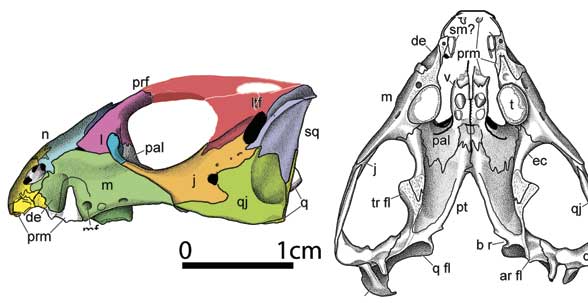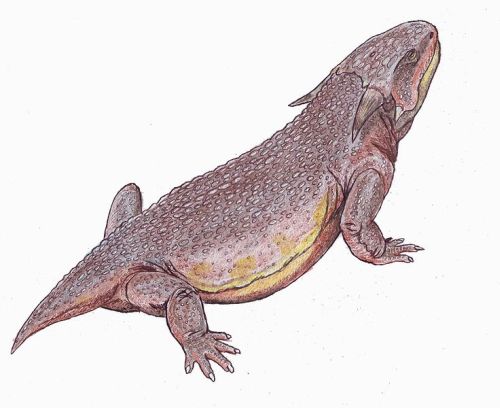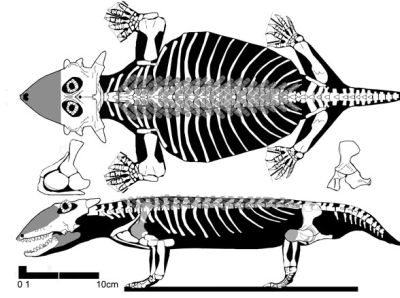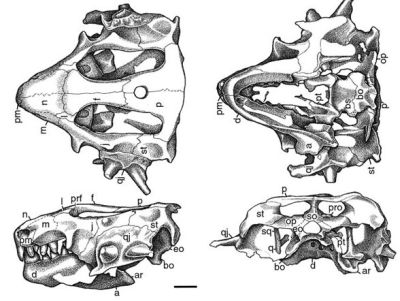| Anapsida | ||
| The Vertebrates | Leptopleuroninae |
| Vertebrates Home | Vertebrate | Vertebrate |
|
Abreviated Dendrogram
Reptiliomorpha
├─Synapsida
└─┬─Eureptilia
│
└─Anapsida
├─┬─Millerettidae
│ └─Eunotosaurus
├─Mesosauridae
└─┬─Lanthanosuchoidea
└─┬─Bolosauridae
└─Procolophonia
├─┬─Nycteroleteridae
│ └─Pareiasauridae
└─Procolophonoidea
├─Owenettidae
│ └?─Testudines
└─Procolophonidae
├─Procolophoninae
└─Leptopleuroninae
├─Anomoiodon
└─┬─Phonodus
├─Neoprocolophon
└─┬─Sclerosaurus
└─Leptopleuronini
├─Leptopleuron
└─Hypsognathus
|
Contents
Overview |
Leptopleuroninae Ivakhnenko 1979 = Telerpetontidae Lydekker, 1888
Phylogenetic definition: All taxa more closely related to Leptopleuron lacertinum Owen 1851 than to Procolophon trigoniceps Owen 1876 (Cisneros 2006)
Range: Triassic of Eur, Nth Am, China, Brazil
Phylogeny: Procolophonidae ::: "Horned procolophonids" : Procolophoninae + * : Anomoiodon + (Phonodus + Neoprocolophon + (Sclerosaurus + Leptopleuronini))
Phylogeny: Leptopleuronini : Leptopleuron + Hypsognathus.
Comments: the most specialised of the procolophonoids, they seem to have evolved in northern Pangea, and hasd supplanted or replaced procolophonines by the late Triassic. Telerpetontidae is the older term and perhaps should be used instead, even if Telerpeton is the junior synonym for Leptopleuron (see comments regarding Podokesauridae and Coelophysidae); for now we have retained the more familiar term as that is the one used in current literature MAK120328
Anomoiodon liliensternivon Huene, 1939
Horizon: Lowest layer of the Chirotherium Sandstone (Middle Bundsandstein) of Reurieth, near Hildburghausen, Germany, Late Olenekian.
Phylogeny: Leptopleuroninae : (Phonodus + Neoprocolophon + (Sclerosaurus + Leptopleuronini)) + *
Phylogeny: Leptopleuronini : Leptopleuron + Hypsognathus.
Size: overall length 10 cm
Comments: Known from two partial skeletons, this poorly known tiny procolophonid was thought to be synonym of Kapes of Russia (Spencer & Storrs, 2002). Cisneros 2006 recovered an unexpected procoplophonine clade consisting of the South African Thelephon (or Thelegnathus) contritus and the Laurasian genus Kapes, known only from tooth bearing fragments. Tsuji and Müller 2009 in their review of the Parareptilia include a very large cladogram, incorporating Cisneros' data for procolophonoids, in which Kapes and Anomoiodon are sister taxa in the aforementioned unnamed clade But before this, when a mold of the holotype of Anomoiodon liliensterni resurfaced in the Berlin Museum. Laura K. Säilä 2008 studied the specimen and, although likewise concluding that Anomoiodon is a sister taxon of Kapes, placing it at the base of the Leptopleurinae rather than the Procolophoninae. (Palaeocritti). It may well be then that Anomoiodon and its relatives are true transitional forms, procolophonines in the process of becoming leptopleuronines MAK120328

Phonodus dutoitorum: Modesto et al. 2010
Range: Katberg Formation in South Africa (Induan - Early Triassic)
Phylogeny: Leptopleuroninae : Anomoiodon + (Neoprocolophon + (Sclerosaurus + Leptopleuronini) + *).
Size: skull length ~2cm
Comments: Known only from a single tiny skull, reminiscent of miniature placodont such as Placodus or Paraplacodus. On this basis, David Peters argues that Phonodus actually is a basal placodont. Since placodonts are themselves highly derived in respect to the original sauropterygian condition (which was more of a standard long-necked marine lizard type thing) we feel that such simlarities in the shape of the skull of , these can be much better explained as convergences. Phonodus is the oldest known member of the subfamily Leptopleuroninae, and was likely the result of a procolophonid migration into the Karoo Basin from Laurasia after the Permo-Triassic extinction event. Because Phonodus had large maxillary teeth underneath a large antorbital buttress (a bony prominence in front of the eye), and a lack of ventral temporal emargination along the side of the skull, it probably had a durophagous diet. (Modesto et al. 2010) Wikipedia, which might explain the placodont convergences, although there is no guarantee that placodonts themselves even were mollusc eaters (Diedrich 2011)
Graphics Skull reconstruction copied from David Peters
Neoprocolophon asiaticus Young, 1957
Range: Yushe, Shanxi, China; Ningwuan land vertebrate faunachron, Anisian (Lucas 2001)
Phylogeny: Leptopleuroninae : Anomoiodon + Phonodus + ((Sclerosaurus + Leptopleuronini) + *)
Comments: known from a single skull which closely resembles that of Procolophon, but differs in the very anterior (towards the front of the skull) placement of the gradatojugal "horns" (Lucas 2001 p.103). Stratigraphically younger than the procolophonid Eumetabolodon. Cisneros 2006 found the Chinese procolophonids Pentaedrusaurus ordosianus and Neoprocolophon asiaticus resolved as the most primitive members of the Leptopleuroninae, with Pentaedrusaurus being more basal than Neoprocolophon. MAK120329
Unnamed clade : Sclerosaurus, Leptopleuron, Hypsognathus
Range: Triassic of Eur, Nth Am & Sth Am
Phylogeny: Leptopleuroninae : Anomoiodon + (Phonodus + Neoprocolophon + * : Sclerosaurus + Leptopleuronini)
Characters: Two or more quadratojugal spines; two jugal spines; convex temporal ventral margin; no maxillary depression. (Cisneros 2006 p.98).
Comments: Cisneros 2006 found the the sclerosaurines (Sclerosaurus armatus + Scoloparia glyphanodon) and the leptopleuronines (Leptopleuron lacertinum, Soturnia caliodon and Hypsognathus fenneri.) to be the best supported clade within the Procolophonidae ("Clade P"). It consists of derived leptopleuronines with very distinctive characteristics, such as the presence of multiple cranial spines. MAK120328

Sclerosaurus armatus: von Meyer in Fischer, 1857; monotypal family Sclerosauridae
Synonyms Labyrinthodon ruetimeyeri Wiedersheim, 1878; Aristodesmus ruetimeyeri (Wiedersheim, 1878) Seeley, 1896.
Range: Upper Middle to Upper Buntsandstein (Olenekian-Anisian) of southern Germany and northern Switzerland
Phylogeny: Leptopleuroninae : Anomoiodon + Phonodus + (Neoprocolophon + (Leptopleuronini + * )).
Characters: distinguished from other known parareptiles by the possession of long, posterolaterally projecting spikes formed by supratemporals, posterior dentary teeth with mesiolingually aligned and slightly imbricating crowns, and a narrow band of dorsal dermal armor comprising two or three rows of sculptured osteoderms on either side of the midline. - Sues & Reisz 2008
Size: Length 30 cm

Comments: a problematic genus that has been interpeted as either a procolophonoid (von Huene, 1912; Colbert, 1946; Carroll, 1988), or a pareiasaur (Romer, 1966). Lee 1995 and Jalil & Janvier 2005 found that Sclerosaurus resolves as the sister taxon of Pareiasauria (the two together constituting the Pareiasauroidea) Redescription and reassessment of this taxon by Sues & Reisz 2008 returned it to the Procolophonidae. Apomorphic character states such as the presence of three spines on the quadratojugal, support its referral to the Leptopleuroninae, a placement also given by Cisneros 2006 in his detailed study of the Procolophonidae. Stratigraphically, an early to mid Triasisc age makes pareiasaur affiliations less likely. Although Sclerosaurus resembles pareiasaurs in the presence of an intercondylar canal on the distal end of the femur, the absence of gastralia, larger size (albeit still very small by pareaisaur standards) and having a short tail Sues & Reisz 2008 and dorsal armor consisting of rows of osteoderms (there are also two spikes protruding from the back of its head) (Palaeocritti) these would be the result of convergences, and even occupying the ecological niche left vacant by the pareiasaurs as a result of the P-T extinction event. Cisneros 2006 finds that Sclerosaurus and Scoloparia (Carnian of Nova Scotia) group together in an unnamed clade ( Sclerosaurini?). Considering the long stratigraphic between the two and absense of intermediate forms this would imply that Triassic microverterberate evolution is as yet still poorly known. Or similarities may have been the result of convergences. These are also the only two procolophonid species where the presence of osteoderms is known. It is however quite likely that osteoderms will be discovered elsewhere. Since the common ancestors of pareiasaurs and procolophonids were not armoured, this is clearly an example of convergent evolution, although a tendency to develop osteoderms may still be a shared ancestral trait of the procolophonia (like proto-feathers for dinosaurs)
The wide and rather flat body (proportionally as wide as a pareiasaur) means that Sclerosaurus may have looked something like an overgrown horned lizard, Phrynosoma (David Peters), although if Juan Carlos Cisneros' suggestion is correct, the Australian thorny devil would be a better metaphor, and perhaps more similar in appearance. Phrynosoma also burrows in loose sand, and in this regard it would be like procolophonids such as Procolophon and Sauropareion , the wide flat body aiding in burrowing (deBraga 2003). MAK120324.
Graphics life reconstruction by Dmitry Bogdanov, Wikipedia, GNU Free Documentation/Creative Commons Attribution Share Alike; skeletal reconstruction © David Peters, used with permission
Leptopleuronini : Leptopleuron, Hypsognathus
Range: Triassic of Eur, Nth Am, Sth Am
Phylogeny: Leptopleuroninae : Anomoiodon + (Phonodus + (Neoprocolophon + (Sclerosaurus + * : Leptopleuron + Hypsognathus.)))
Comments: an unnamed procolophonid from the Owl Rock Member of the Chinle Formation may belong here; although poorly preserved, it shares some apomorphies known elsewhere only in Leptopleuron, Soturnia and Hypsognathus, such as the presence of a single dentary incisiform (Fraser et al., 2004 cited in Cisneros 2006 p.98). According to Cisneros 2006, Soturnia caliodon, from the Late Triassic of Brazil, is the only known Gondwanan leptopleuronine, and sister taxon to Hypsognathus. The otherwise absense of leptopleuronines from Gondwana may be due to preservational or collecting biases, or it may mean that leptopleuronines only spread southward during the late Triassic MAK120328
Leptopleuron lacertinum Owen, 1851
Synonym: Telerpeton elginense Mantell, 1852
Sratigraphic range: Lossiemouth Sandstone Formation of Grampian, Scotland (early Norian).
Phylogeny: Leptopleuronini : Hypsognathus + *
Comments: similar to Procolophon, but with wider molar-like teeth, no gastralia, and hind limbs more slender
Links Palaeocritti MAK120330

Hypsognathus fenneri Gilmore, 1928
Sratigraphic range: Brunswick (now upper Passaic) Formation, Clifton, New Jersey, Newark Supergroup of eastern North America (late Norian–Rhaetian); Blomidon Formation of Nova Scotia and upper part of the New Haven Formation of Connecticut, Passaic Formation of the Newark basin in southeastern Pennsylvania. Palaeocritti
Phylogeny: Leptopleuronini : Leptopleuron + *
Size: length: 33 cm, skull width up to 12.5 cm
Comments: widely regarded as the most derived procolophonid. The dorsally open orbit extends deeply into the parietal, posterior to the pineal opening. Presumeably the eyeball occupied only the anterior half of this opening with jaw muscles filling the rest. The quadratojugal is ornamented with "horns." The postcranial portion was low and wide, as in the distantly related Sclerosaurus. - David Peters. Like procolophon, a herbivore with chisel-shaped teeth designed for dealing with tough vegetation (Colbert, 1946; )
Graphics Hypsognathus fenneri, reconstruction of skull, from Sues et al 2000. Abbreviations: a, angular; ar, articular; c, coronoid process; d, dentary; f, frontal; j, jugal; la, lacrimal; m, maxilla; n, nasal; p, parietal; pf, prefrontal; pm, premaxilla; po, postorbital; pof, postfrontal; q, quadrate; qj, quadratojugal; sa, surangular; sq, squamosal; st, supratemporal.
page MAK120328